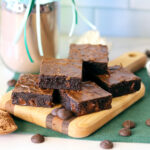
DIY Brownie Mix - Preparation Instructions
Start with a batch of DIY brownie mix then simply add butter and eggs to make delicious, fudgy, cocoa brownies whenever the craving strikes.
Servings 32
Calories 153kcal
Equipment
- mixing bowl
- brownie pan (8"x8" or 9"x13")
Ingredients
To prepare 8x8 pan brownies:
- 2 cups
DIY brownie mix - ½ cup butter melted
- 2 eggs
- 1 egg yolk
To prepare 9x13 pan brownies:
- 4 cups
DIY brownie mix - 1 cup butter melted
- 5 eggs
Instructions
To prepare 8x8 pan brownies:
- In a medium bowl, whisk together the melted butter, eggs and egg yolk until well combined.1/2 cup butter, 2 eggs, 1 egg yolk
- Add the brownie mix and stir until the mixture is smooth and no dry ingredients are visible. If your mix did not include chocolate chips (or other mix-ins) and you'd like to add them, fold them in just until they are evenly distributed.2 cups DIY brownie mix
- Let the batter rest while you line an 8"x8" metal brownie pan with non-stick foil or parchment paper and preheat your oven to 350°F.
- Transfer the batter to the prepared pan and smooth the top. Bake in the preheated oven for about 18-20 minutes. The edges should be set and slightly puffed, the top should be dry and glossy. For perfect, fudgy brownies, the middle should appear not quite set, avoid overbaking.
To prepare 9x13 pan brownies:
- In a medium to large bowl, whisk together the melted butter and eggs until well combined.1 cup butter, 5 eggs
- Add the brownie mix and stir until the mixture is smooth and no dry ingredients are visible. If your mix did not include chocolate chips (or other mix-ins) and you'd like to add them, fold them in just until they are evenly distributed.4 cups DIY brownie mix
- Let the batter rest while you line an 9"x13" metal baking pan with non-stick foil or parchment paper and preheat your oven to 350°F.
- Transfer the batter to the prepared pan and smooth the top. Bake in the preheated oven for about 30-34 minutes. The edges should be set and slightly puffed, the top should be dry and glossy. For perfect, fudgy brownies, the middle should appear not quite set, avoid overbaking.
Notes
Note that the 32 servings listed is for the 9"x13" pan preparation. Unless you want brownie bites, I would recommend cutting the 8"x8" pan preparation into 16 bars. When following this recommendation, the nutrition information remains pretty consistent for either preparation.
It can be a bit more difficult to achieve the quintessential, glossy, crackly brownie crust when starting from a mix as you have less opportunity to fully dissolve the sugar without over mixing the batter, but, if that is your goal, here are a few tips:
- Make sure your eggs are not just room temperature, but actually warm. You can bring the eggs up to about 100°F in the shell without cooking the eggs. Simply place them in a container and cover them with about 110°-115°F water and keep them there until the temperature equalizes to 100°F.
- When you melt the butter, make sure it gets to about 110°F (if you are doing this in the microwave, be careful not to heat it too rapidly so it does not pop/explode all over the interior of your microwave)
- The relatively low water content in the liquid ingredients and the addition of cornstarch makes it a bit more difficult to develop gluten (that is a good thing in this case!) so you can stir the batter a bit longer (until it is smooth and glossy and a little bit syrupy in appearance) to encourage the sugar to dissolve.
- Because you are heating your liquid ingredients above the melting temperature of chocolate, I recommend not including any chocolate chips in the dry mix for this preparation method. Instead, add them after the batter is well mixed and while it is still warm enough to just start to melt the chocolate. That little bit of melted chocolate in the batter will help with forming the desired crust.
Nutrition
Serving: 1brownie | Calories: 153kcal | Carbohydrates: 21g | Protein: 2g | Fat: 8g | Saturated Fat: 5g | Polyunsaturated Fat: 0.4g | Monounsaturated Fat: 2g | Trans Fat: 0.2g | Cholesterol: 41mg | Sodium: 130mg | Potassium: 66mg | Fiber: 1g | Sugar: 16g | Vitamin A: 217IU | Calcium: 12mg | Iron: 1mg